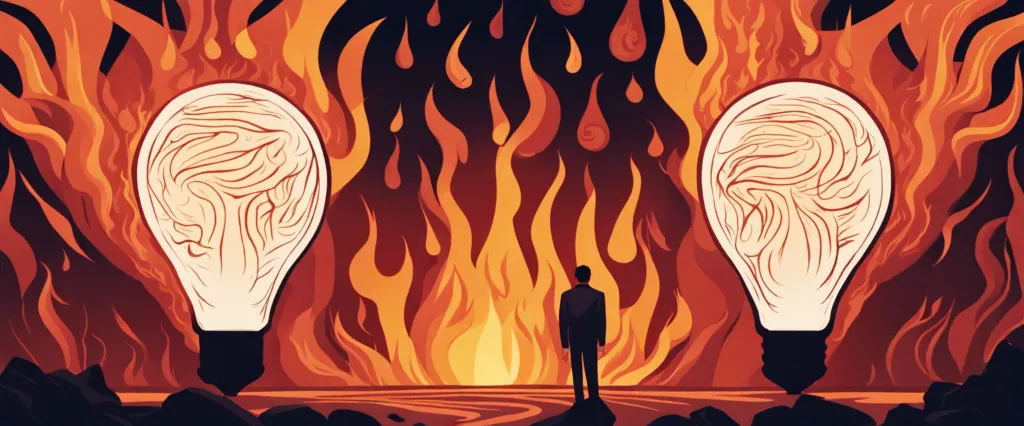In “Burnout,” Emily Nagoski explores the detrimental effects of chronic stress and burnout on our physical and mental well-being. As a well-known sex educator and author, Nagoski offers insights and strategies for managing stress and reclaiming joy and balance in our lives.
Chapter 1: Understanding the concept of burnout and its impact on well-being.
In Chapter 1 of “Burnout” by Emily Nagoski, the concept of burnout is introduced as a state of emotional, physical, and mental exhaustion caused by prolonged stress. Nagoski explains that burnout is often the result of chronic workplace stress, but can also be triggered by personal or relationship issues. She emphasizes that burnout is not simply a case of feeling tired or overwhelmed; it is a serious condition that can have profound impacts on an individual’s well-being.
Nagoski delves into the various symptoms of burnout, including feelings of cynicism, detachment, and lack of accomplishment. She underscores the importance of recognizing these signs and taking steps to address them before burnout escalates and leads to more serious consequences.
The chapter also explores the impact of burnout on a person’s overall health and well-being. Nagoski discusses how chronic stress can have detrimental effects on the body, including increased risk of heart disease, depression, and anxiety. She highlights the importance of addressing burnout through self-care practices and seeking professional help when necessary.
Overall, Chapter 1 sets the stage for understanding burnout as a complex and multifaceted issue that can have significant implications for an individual’s quality of life.
Chapter 2: Exploring the physiological and psychological factors contributing to burnout.
Chapter 2 of “Burnout” by Emily Nagoski delves into the physiological and psychological factors that can contribute to feelings of burnout. Nagoski explains how our bodies and brains respond to stress, and how these responses can ultimately lead to burnout if not properly managed.
Physiologically, chronic stress can cause our bodies to be in a constant state of fight-or-flight mode, which can lead to exhaustion and dysregulation of various bodily systems. This can manifest as symptoms such as fatigue, headaches, and digestive issues.
Psychologically, burnout can be influenced by factors such as perfectionism, lack of autonomy, and feeling disconnected from one’s work or purpose. Nagoski emphasizes the importance of recognizing these factors and taking steps to address them in order to prevent burnout.
Nagoski also explores the concept of emotional exhaustion, which can result from consistently ignoring one’s emotions or not allowing oneself to fully experience and process them. This can further contribute to feelings of burnout and overwhelm.
Overall, Chapter 2 highlights the complex interplay between physiological and psychological factors in the experience of burnout, and provides insights into how individuals can begin to address these factors in order to prevent and recover from burnout.
Chapter 3: Insights into the role of stress and the body’s response to prolonged pressure.
In Chapter 3 of “Burnout” by Emily Nagoski, the author delves into the role of stress and how our bodies respond to prolonged pressure. Nagoski explains that stress is not a mere psychological reaction, but a physiological one as well. When we experience stress, our bodies release cortisol and adrenaline, which prepare us for fight-or-flight responses. This is a helpful mechanism in moments of acute stress, but becomes harmful when stress is chronic.
Nagoski discusses how prolonged exposure to stress can lead to burnout, as the body continues to release cortisol and adrenaline at high levels, causing wear and tear on the body. This can result in a variety of physical symptoms such as fatigue, digestive issues, headaches, and weakened immune system.
The chapter emphasizes the importance of recognizing the signs of stress and burnout in order to address them effectively. Nagoski provides strategies for managing stress and preventing burnout, such as exercise, relaxation techniques, and setting boundaries to protect one’s mental and physical well-being. By understanding the impact of stress on the body, individuals can take proactive steps to prevent burnout and prioritize self-care.
Chapter 4: Examination of societal expectations and their influence on burnout.

Chapter 4 of “Burnout” examines societal expectations and their influence on burnout. The author, Emily Nagoski, argues that societal norms and expectations often contribute to feelings of burnout by placing unrealistic demands on individuals. She discusses how societal messages about success, productivity, and self-worth can lead to feelings of inadequacy and overwhelm.
Nagoski acknowledges the pressures that individuals face to meet societal expectations, such as being highly productive, always available, and constantly striving for success. These expectations can be particularly challenging for women, who are often socialized to prioritize others’ needs over their own.
The chapter also explores the concept of emotional labor and how it can contribute to burnout. Emotional labor involves managing one’s emotions to meet the demands of a given situation, and Nagoski argues that this constant emotional regulation can be exhausting and draining.
Overall, Nagoski highlights the need for individuals to challenge societal expectations and set boundaries to protect their well-being. By recognizing and reframing these expectations, individuals can reduce feelings of burnout and cultivate a healthier relationship with themselves and others.
Chapter 5: Analysis of gender dynamics and their connection to burnout experiences.
In Chapter 5 of “Burnout” by Emily Nagoski, the author explores the connection between gender dynamics and burnout experiences. Nagoski discusses the societal expectations placed on individuals based on their gender, and how these expectations can contribute to feelings of burnout. She highlights the different ways in which men and women are socialized to deal with stress and emotions, and how these gendered norms can impact their experiences of burnout.
Nagoski also delves into the concept of emotional labor, which is often expected of women in both their personal and professional lives. This emotional labor can lead to increased stress and burnout for women, as they juggle multiple responsibilities and expectations.
Furthermore, Nagoski examines how societal norms around masculinity can also contribute to burnout experiences for men. Men are often socialized to suppress their emotions and prioritize work over their well-being, which can lead to feelings of burnout and emotional exhaustion.
Overall, Chapter 5 of “Burnout” sheds light on the ways in which gender dynamics play a significant role in shaping individuals’ experiences of burnout, and emphasizes the importance of understanding and challenging these societal expectations in order to prevent and address burnout effectively.
Chapter 6: Discussions on strategies for managing and preventing burnout.
In Chapter 6 of “Burnout” by Emily Nagoski, the focus shifts to strategies for managing and preventing burnout. Nagoski emphasizes that self-care is essential in combating burnout, but it is not just about bubble baths and spa days. Instead, she suggests engaging in activities that truly recharge and energize you, such as spending time with loved ones, doing hobbies you enjoy, or getting out in nature.
Nagoski also discusses the importance of setting boundaries and learning to say no when necessary. She explains that saying yes to everything can lead to overwhelm and burnout, so it is crucial to prioritize and delegate tasks when possible. Additionally, Nagoski highlights the significance of developing a support network and seeking out professional help if needed.
Furthermore, the chapter delves into the idea of finding purpose and meaning in your work to help combat burnout. Nagoski explains that having a sense of fulfillment and satisfaction in your job can act as a buffer against burnout. She also suggests practicing mindfulness and gratitude to cultivate a positive mindset and reduce stress.
Overall, Chapter 6 offers practical strategies and advice for managing and preventing burnout, emphasizing the importance of self-care, setting boundaries, seeking support, finding purpose, and practicing mindfulness.
Chapter 7: Contemplations on self-care practices and boundaries to combat burnout.
In Chapter 7 of “Burnout” by Emily Nagoski, the focus is on self-care practices and setting boundaries to combat burnout. Nagoski emphasizes the importance of taking care of oneself in order to prevent burnout and maintain well-being. She discusses the concept of “emotional hygiene,” which involves practicing self-compassion, setting boundaries, and prioritizing self-care.
Nagoski provides practical tips for implementing self-care practices, such as engaging in activities that bring joy, setting realistic goals, and incorporating relaxation techniques into daily routines. She also emphasizes the importance of setting boundaries to protect one’s physical, emotional, and mental well-being. This can involve saying no to excessive commitments, practicing assertiveness, and communicating needs effectively.
Overall, Nagoski’s guidance in this chapter highlights the significance of implementing self-care practices and boundaries in order to combat burnout and foster resilience. By prioritizing self-care and setting boundaries, individuals can better manage stress, prevent burnout, and promote overall well-being in their personal and professional lives.

Chapter 8: Provocations to redefine success and prioritize well-being in the face of burnout.
In Chapter 8 of “Burnout” by Emily Nagoski, the focus shifts to redefining success and prioritizing well-being in order to combat burnout. Nagoski discusses how societal expectations and cultural norms often contribute to feelings of inadequacy and burnout, urging readers to question these definitions of success and make choices that prioritize their own well-being.
Nagoski explores the concept of “rest ethic,” emphasizing the importance of rest and relaxation in maintaining overall health and productivity. She suggests that by embracing rest as a valuable and necessary part of life, individuals can combat feelings of burnout and overwhelm.
Furthermore, Nagoski challenges the notion that success is solely defined by achievements and productivity. She encourages readers to consider their values and personal goals, and to redefine success in ways that are meaningful and sustainable for them. By prioritizing well-being and self-care, individuals can create a healthier and more fulfilling life that is less susceptible to burnout.
Overall, Chapter 8 serves as a call to action for readers to reassess their priorities, redefine success on their own terms, and make choices that promote well-being and resilience in the face of burnout.
After Reading
In conclusion, “Burnout” by Emily Nagoski provides a comprehensive and insightful examination of the causes and consequences of burnout, particularly in relation to gender and societal expectations. By exploring the science behind stress and offering practical strategies for overcoming burnout, Nagoski empowers readers to reclaim their well-being and live more fulfilling lives. With its blend of research, personal anecdotes, and actionable advice, “Burnout” is a valuable resource for anyone feeling overwhelmed and exhausted in today’s fast-paced world.
1. “The Art of Rest: How to Find Respite in the Modern Age” by Claudia Hammond – This book delves into the importance of rest and relaxation in combating burnout and offers practical strategies for finding balance in a busy world.
2. The Power of Full Engagement: Managing Energy, Not Time, Is the Key to High Performance and Personal Renewal” by Jim Loehr and Tony Schwartz – This book explores the concept of managing energy rather than time to prevent burnout and achieve greater success in both personal and professional life.
3. “Daring Greatly: How the Courage to Be Vulnerable Transforms the Way We Live, Love, Parent, and Lead” by Brené Brown – Brené Brown’s work on vulnerability and shame offers valuable insights into overcoming burnout by embracing authenticity and self-compassion.
4. “Mindfulness: An Eight-Week Plan for Finding Peace in a Frantic World” by Mark Williams and Danny Penman – This book provides a practical guide to incorporating mindfulness practices into daily life to reduce stress, increase resilience, and prevent burnout.
5. The Happiness Advantage: The Seven Principles of Positive Psychology That Fuel Success and Performance at Work” by Shawn Achor – This book explores the science of happiness and positive psychology, offering strategies for increasing happiness and well-being to prevent burnout and improve overall performance.




